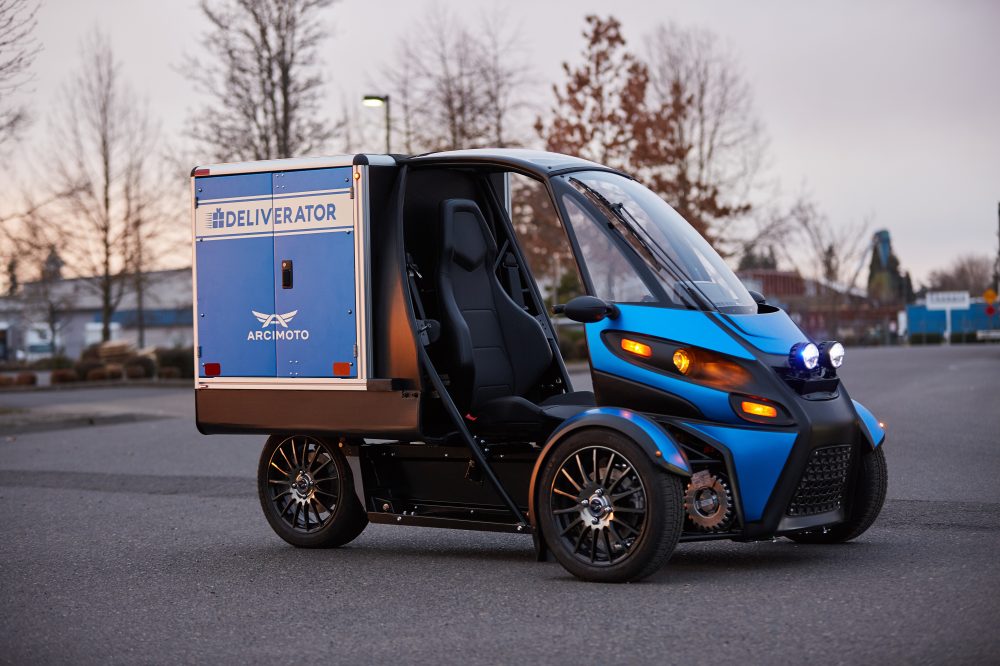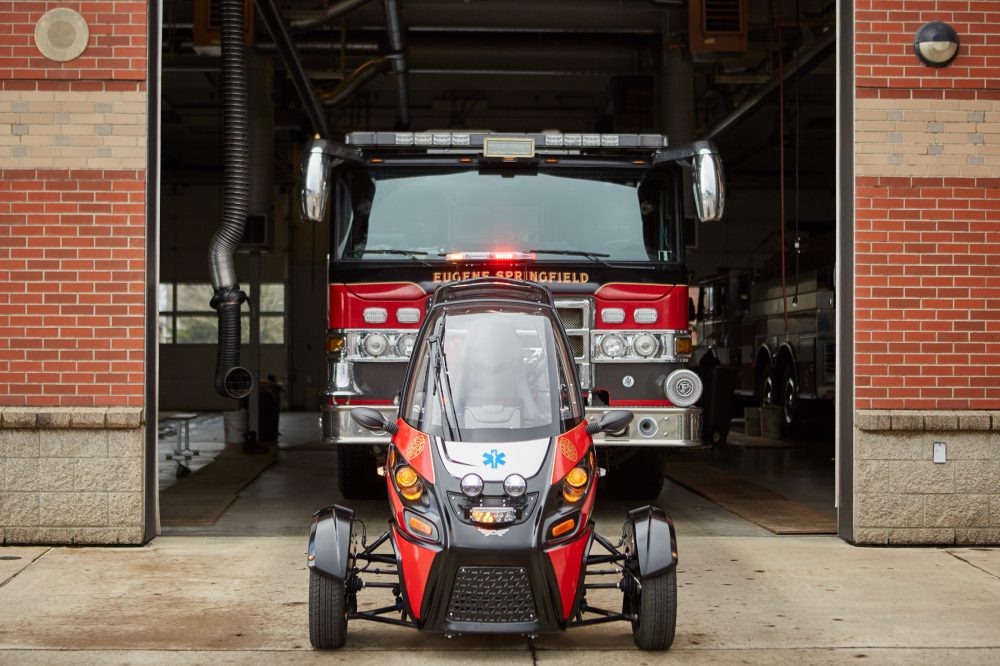Arcimoto, an Oregon-based electric vehicle manufacturer, is famous for its three-wheeled Fun Utility Vehicle (FUV). The FUV was originally designed as a passenger vehicle, but the company is now showing off two new versions for emergency services and delivery companies.
The Arcimoto FUV is a semi-enclosed motorcycle-class vehicle. It adopts a tadpole trike configuration with two wheels in the front. Tadpole trikes are more stable than conventional two rear-wheeled tricycles. Thus, this design is much more common in three–wheeled EVs.
Arcimoto Deliverator FUV
Arcimoto has dubbed the delivery model the “Deliverator.”
The Deliverator is intended for fleets and small businesses. Arcimoto believes that it can help such companies save costs compared to traditional delivery vehicles.
Arcimoto is targeting a city range of 100 miles (161 km) and a top speed of 75 mph (121 km/h). Those figures would allow the Deliverator to operate most of the day in the city yet still give it access to highways.

The Deliverator should also feature a 350 lb (159 kg) cargo capacity and up to 20 cubic feet (566 liters) of onboard storage space.
Arcimoto believes that the Deliverator will be more efficient by an order of magnitude than traditional delivery vans and trucks, yet take up just one-quarter of the footprint.
According to Mark Frohnmayer, President and Founder of Arcimoto:
“With the Deliverator, we set out to create a vehicle that would solve the problem of local and last-mile delivery, which has traditionally been dominated by big, expensive, polluting delivery trucks and vans that often block traffic and increase congestion in urban environments. The Deliverator’s nimble, small footprint can improve fulfillment and delivery times by allowing the operator to more easily move through traffic and find parking compared to a full-sized automobile. With reduced fuel and maintenance costs, we believe the Deliverator will offer significant per-mile savings.”
The Deliverator starts at $19,990 and is available for pre-order now.
While the Deliverator isn’t the first electric delivery vehicle, it is certainly one of the more unique ones.
Arcimoto’s Rapid Responder
The second specialty vehicle developed on the FUV base is the Arcimoto Rapid Responder. It is designed for emergency services and can help supplement vehicles such as fire trucks and ambulances.
Just like with the Deliverator, Arcimoto believes that the Rapid Responder can help perform many of the duties of traditional ICE vehicles used by first responders, yet at a fraction of the cost.

Arcimoto also announced that it has agreed in principle to test the Rapid Responder Fleet in pilot programs with the City of Eugene, the Eugene Springfield Fire Department, and the city of Eastvale, California. Arcimoto anticipates that the first production Rapid Responders will be delivered in 2020.
According to Frohnmayer:
“Arcimoto’s ultra-efficient three-wheeled platform offers real advantages for rapid response applications. We believe that its small-footprint, maneuverability, and instant torque will allow first responders to more quickly move through congested urban cores during emergencies, and its extraordinary efficiency will help fleets meet their long term emissions goals. More than anything, we are excited to create a vehicle that helps save lives.”
Electrek’s Take
These vehicles aren’t cheap, but I do see a place for them. They are larger than a motorcycle or scooter, yet smaller than a traditional car or van. That makes them more nimble in urban environments.
There are a lot of delivery companies that don’t really need a giant panel van or lift gate truck. Many times, these delivery vehicles are driving around with only a small load in the back. In such cases, a smaller electric vehicle would make a lot of sense. While some companies may be able to replace their entire delivery fleet with vehicles like the Deliverator, it is more likely that many will be able to replace a portion of their vehicles, using the Deliverator to supplement their fleet and increase their overall efficiency.
For first responders, smaller vehicles make sense. You can’t replace full-size ambulances or fire trucks entirely, of course. But if you can get a first responder out there sooner by slicing through traffic so that he or she can begin life-saving aid quicker, the difference can be life or death.
When I lived in Tel Aviv, a huge portion of the paramedic vehicle fleet was comprised of scooters with a big first aid box on the back. They inevitably arrived at the scene of emergencies first to begin giving aid. Then the evacuation ambulance would arrive a few minutes later after navigating through the traffic. It blows my mind that the same doesn’t exist yet in the US. Smaller EVs could have a big impact on response times and the outcome of emergencies.
Obviously the price of these vehicles is quite high compared to a cheap panel van, though there is an argument for the better lifetime cost of electric vehicles. And with Arcimoto targeting an eventual $12,000 price for base models, these might not be so expensive in a few years.
What do you think of Arcimoto’s new fleet vehicles? Let us know in the comments below.
FTC: We use income earning auto affiliate links. More.

